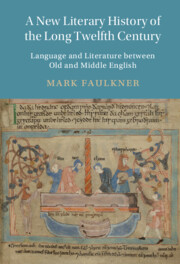 A New Literary History of the Long Twelfth Century
A New Literary History of the Long Twelfth Century from Part II - The Affordances of English
Published online by Cambridge University Press: 14 July 2022
This chapter considers the maintenance of the Anglo-Saxon Chronicle at Christ Church Canterbury in the first decade of the twelfth century, as well as the acquisition, adaptation, expansion and recopying of earlier manuscripts of the Chronicle contemporary with it. It argues those involved were of both English and foreign descent and worked with a knowledge of the template for vernacular annalistic writing laid down in King Alfred’s reign and developed over the succeeding 150 years. However, in their overt monastic chauvinism, length, use of first person pronouns and direct speech and disregard for chronological organisation, their additions, especially of documents, also anticipated developments in twelfth-century historiography. The Chronicle tradition in effect came to an end at Christ Church by the 1120s, elsewhere by the 1130s, a consequence of changes in the twelfth-century linguistic ecology, the success of Latin translations and, arguably, the innovations introduced by its early twelfth-century adapters.
To save this book to your Kindle, first ensure [email protected] is added to your Approved Personal Document E-mail List under your Personal Document Settings on the Manage Your Content and Devices page of your Amazon account. Then enter the ‘name’ part of your Kindle email address below. Find out more about saving to your Kindle.
Note you can select to save to either the @free.kindle.com or @kindle.com variations. ‘@free.kindle.com’ emails are free but can only be saved to your device when it is connected to wi-fi. ‘@kindle.com’ emails can be delivered even when you are not connected to wi-fi, but note that service fees apply.
Find out more about the Kindle Personal Document Service.
To save content items to your account, please confirm that you agree to abide by our usage policies. If this is the first time you use this feature, you will be asked to authorise Cambridge Core to connect with your account. Find out more about saving content to Dropbox.
To save content items to your account, please confirm that you agree to abide by our usage policies. If this is the first time you use this feature, you will be asked to authorise Cambridge Core to connect with your account. Find out more about saving content to Google Drive.